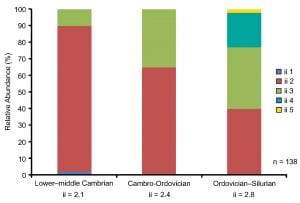The Evolution of Bioturbation
In order to resolve the ecological-environmental feedbacks that accompanied the emergence of animal-dominated seafloor ecosystems, we use the sedimentary and trace fossil records to investigate the evolution of infaunal (sediment-dwelling) animals and bioturbating (burrowing and sediment-mixing) behaviors. The radiation of bioturbating animals is frequently invoked as the trigger for a myriad of geochemical, ecological and preservational phenomena associated with the Cambrian Explosion, such as oxygenation of the seafloor and deep ocean and the closing of several key windows of exceptional fossilization. However, the evolution of the mixed layer—the zone of sediments physically and chemically homogenized by burrowing animals and the zone which is mechanistically most responsible for the ecological, biogeochemical and preservational impact of bioturbation—has, historically, been poorly constrained. Our recent field-based sedimentological and paleontological work, coupled with geochemical modeling, has indicated that the development of the sedimentary mixed layer was a protracted process. The implementation of efficient sediment-mixing behaviors lagged behind both the Cambrian Explosion and the Great Ordovician Biodiversification Event, and the delayed development of bioturbation directly impacted marine sulfate concentrations and the rheology of the early Paleozoic seafloor (Tarhan et al., 2015, Nature Geoscience; Tarhan, 2018, Geology; Tarhan, 2018, Earth-Science Reviews; Tarhan and Droser, 2014, Palaeo-3), and may have facilitated enhanced phosphorus recycling and productivity, thus spurring greater ecosystem complexity and ocean-atmosphere oxygenation (Tarhan et al., 2021, EPSL; Zhao et al., 2020, Nature Communications). Bioturbation was also remarkably heterogeneous across seafloor environments (Tarhan et al., 2023, Geobiology).

From Tarhan, 2018, Earth-Science Reviews

From Tarhan, 2018, Earth-Science Reviews

From Tarhan, 2018, Earth-Science Reviews

From Tarhan et al., 2015, Nature Geoscience


From Tarhan, 2018, Geology

